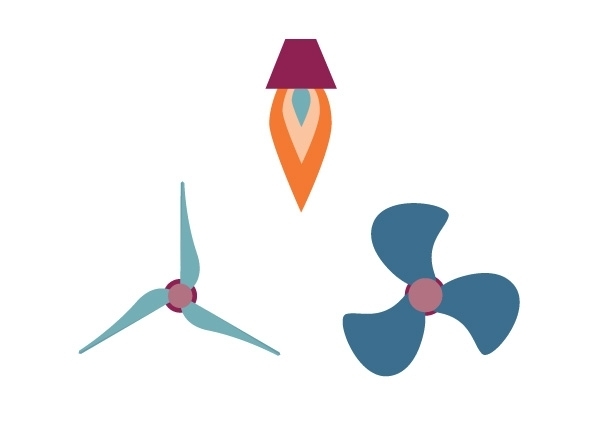Propulsion

The study of Propulsion, a core technology in Aerospace and Ocean Engineering, focuses on learning and applying fundamental knowledge to understand the nature, scope, opportunities and challenges of designing, specifying and integrating propulsion technologies. The Propulsion Track will allow students with a particular interest in the design, and analysis of aircraft, spacecraft or ocean propulsion to focus their technical electives in that area. This Track is available to all Aerospace and Ocean Engineering majors.
Choose a minimum of 9 credit hours from the following courses.
| Course | Title | CH |
|---|---|---|
| AOE 3044 | Boundary Layer Theory | 3 |
| AOE 4174 | Spacecraft Propulsion | 3 |
| AOE 4234 | Aerospace Propulsion Systems | 3 |
| AOE 4474 | Propellers and Turbines | 3 |
| AOE 4604 | Booster Design, Fabrication, and Operation | 3 |
| AOE 4624 | Foundations of Aero and Hydroacoustics | 3 |
| AOE 4814 | Special Topics in Propulsion | 3 |
| AOE 5144* | Boundary Layer Theory and Heat Transfer | 3 |
| AOE 5154* | Data Analysis in Fluid Dynamics | 3 |
| AOE 5184* | High Speed Propulsion | 3 |
*Graduate School policy: seniors with ≥3.0 GPA may take graduate course with instructor’s permission.
Courses are based on the UG Catalog Date of Entry 2025-2026 program curriculum. Prerequisites may apply – see your advisor.
What is ocean engineering?
Ocean engineers specialize in hydronautics. They develop, design, and analyze technology that operates in the complex environment on or below the surface of oceans, lakes, and rivers.
Ocean engineering technology has applications in scientific discovery, national security and defense, transportation, fishing, recreation, petroleum extraction, and thermal or wave energy capturing, among others.
The field focuses on the design, construction, and science of marine craft and instruments, including:
- Advanced marine craft
- Autonomous underwater vehicles (marine robotics)
- Offshore platforms
- Ships
- Submarines
Ocean engineers must build vehicles, systems, instruments, and sensors to operate smoothly in the unpredictable, often hostile environment of the open seas, which means high winds, rough waves, strong currents, and moving ice.
Today’s ocean engineering challenges include subsea robot design, subsea navigation, and collaborative autonomy to explore the vast, unmapped depths of the ocean.
I. Purpose
Aerospace and ocean engineering majors have a foundational option and eight concentrations:
- Aero/hydrodynamics
- Dynamics, control and estimation
- Energy & environment
- Naval engineering
- Propulsion
- Space engineering
- Structures and materials
- Vehicle and system design
The concentration in propulsion would allow aerospace and ocean engineering students, who were interested primarily in this topic, to develop that specialization.
Students will choose three of the following courses:
- AOE 4174
- AOE 4234
- AOE 4474
- AOE 4814
- ME 3124, ME 4204, and STAT 4714.
This concentration may be completed in conjunction with completing a College of Engineering minor in naval engineering.
II. Justification:
The concentration in propulsion will allow students with a particular interest in the design, and analysis of aircraft, spacecraft or ocean propulsion to focus their technical electives in that area and receive recognition on their transcripts.
III. Hours Requirement
A total of 128 hours is required to graduate with a BS in aerospace and ocean engineering. The concentration in Propulsion requires nine credit hours of coursework out of a total of eighteen hours of Technical Electives.
IV. Eligibility:
The concentration in propulsion will be available to all aerospace and ocean engineering majors. Students majoring in aerospace and ocean engineering may pursue more than one departmental concentration.
V. Relevance:
The study of propulsion, a core technology in aerospace and ocean engineering, focuses on learning and applying fundamental knowledge to understand the nature, scope, opportunities and challenges of designing, specifying and integrating propulsion technologies.
VI. Policies regarding intra-departmental majors and minors:
The AOE department offers majors in both aerospace and ocean engineering. Courses for the two majors overlap. Students may choose to pursue both majors simultaneously.
VII. Required resources
No additional resources are required at present.
VIII. Methods of Communication:
These changes are communicated to students by posting the option checksheet to our department website, e-mail notification via the AOE listserv, and presentation to incoming students at advising sessions.
The AOE academic advisors will discuss the option with students during their advising sessions and concentration checksheets will be available in the AOE Academic Advising Center.


